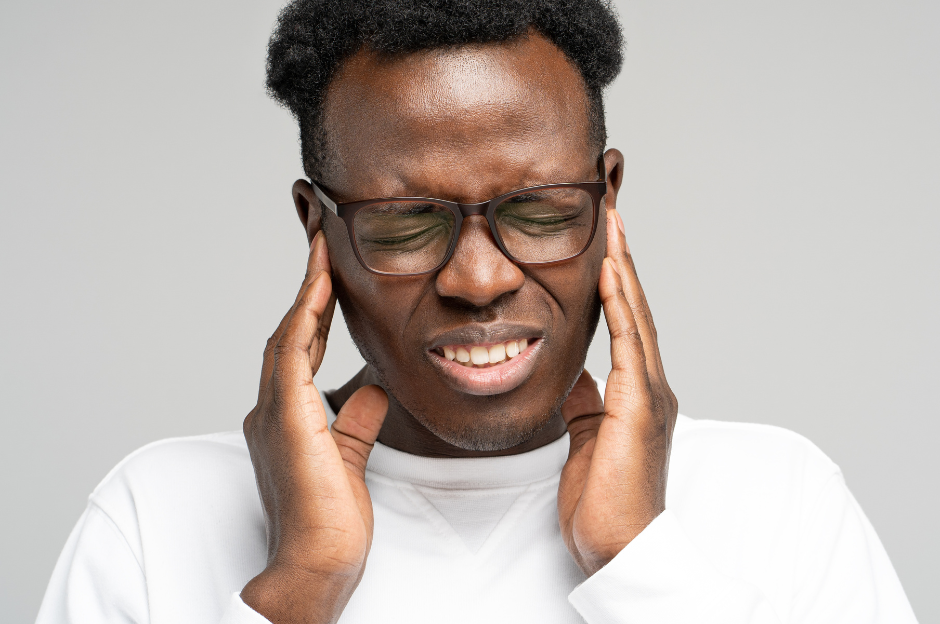
Increased brain activity or “neural gain” within central auditory pathways is thought to underlie the generation of sound perception in tinnitus. Animal models of tinnitus have consistently reported central neural gain (increased spontaneous neural firing rates and neural synchrony) within auditory cortex (AC). These neural changes in animals termed “tinnitus neural/physiologic correlates” have yet to be well-documented in humans.
This clinical translational project utilizes fNIRS to investigate both non-somatic and somatic (somatosensory; ability to modulate sound perception with head and neck movements) tinnitus human participants to objectify and understand where in the central auditory and non-auditory pathways tinnitus perception may be generated. We are also using fNIRS to identify and objectify human tinnitus correlates in the brain that may serve as clinical markers that can inform us about diagnosis, prognosis and treatment outcomes. We are specifically measuring Hemodynamic Responses (HR) and Resting State Functional Connectivity (RSFC).
Project Information
| Subjective and Somatic Tinnitus; Using Functional Near-Infrared-Spectroscopy to Identify Objective Correlates in Auditory and Non-Auditory Cortices | |||
|---|---|---|---|
| Project Number | Principal Investigator | Organization | Fiscal Year |
| 1R01DC021746-01 | Gregory J. Basura | University of Pittsburgh | 2024 |
Publications
Tinnitus and auditory cortex; Using adapted functional near-infrared-spectroscopy to expand brain imaging in humans. Zhai T, Ash-Rafzadeh A, Hu X, Kim J, San Juan JD, Filipiak C, Guo K, Islam MN, Kovelman I, Basura GJ. Laryngoscope Investig Otolaryngol. 2020 Dec 16;6(1):137-144. doi: 10.1002/lio2.510. PMID: 33614942; PMCID: PMC7883618.
Tinnitus and auditory cortex: using adapted functional near-infrared spectroscopy to measure resting-state functional connectivity. San Juan JD, Zhai T, Ash-Rafzadeh A, Hu XS, Kim J, Filipak C, Guo K, Islam MN, Kovelman I, Basura GJ. Neuroreport. 2021 Jan 6;32(1):66-75. doi: 10.1097/WNR.0000000000001561. PMID: 33252478; PMCID: PMC7717476.
Tinnitus Management in Lateral Skull Base Lesions. J Neurol Surg B Skull Base. Juan JS, Basura GJ. 2019 Apr;80(2):125-131. doi: 10.1055/s-0038-1676308. Epub 2018 Nov 30. PMID: 30931219; PMCID: PMC6438796.
Auditory-somatosensory bimodal stimulation desynchronizes brain circuitry to reduce tinnitus in guinea pigs and humans. Marks KL, Martel DT, Wu C, Basura GJ, Roberts LE, Schvartz-Leyzac KC, Shore SE. Sci Transl Med. 2018 Jan 3;10(422):eaal3175. doi: 10.1126/scitranslmed.aal3175. PMID: 29298868; PMCID: PMC5863907.
Human Auditory and Adjacent Nonauditory Cerebral Cortices Are Hypermetabolic in Tinnitus as Measured by Functional Near-Infrared Spectroscopy (fNIRS). Issa M, Bisconti S, Kovelman I, Kileny P, Basura GJ. Neural Plast. 2016;2016:7453149. doi: 10.1155/2016/7453149. Epub 2016 Mar 2. PMID: 27042360; PMCID: PMC4793139.
Bimodal stimulus timing-dependent plasticity in primary auditory cortex is altered after noise exposure with and without tinnitus. Basura GJ, Koehler SD, Shore SE. J Neurophysiol. 2015 Dec;114(6):3064-75. doi: 10.1152/jn.00319.2015. Epub 2015 Aug 19. PMID: 26289461; PMCID: PMC4686295.
